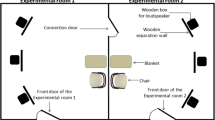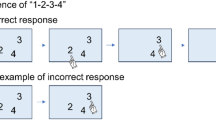Abstract
Six male cats served as subjects in a classical conditioning experiment designed to assess the development of an overt conditioned response with experimental parameters that had been demonstrated to produce conditioning of neuro-electrical activity in immobilized cats. The subjects were physically restrained by means of an adjustable full-body cast during the experimental sessions which consisted of 75 habituation trials (light flash alone) followed by 225 trials with light and shock paired in a trace conditioning manner, and 75 additional extinction trials (light alone).
The subjects were divided into two groups, and three different experimental sessions were given to each on three consecutive days. Group I received low US intensity (18 v) conditioning on the first day, high US (45–85 v) conditioning on Day 2 and pseudoconditioning on Day 3. Group II received the same sessions, but in a pseudoconditioning —high US—low US order. The results indicated that a conditioned leg movement was produced when the CS was paired in a trace conditioning fashion with either the high or low intensity shock US. The development of the conditioned leg movement across trials was found to be very similar to that of the conditioned neural activity in a previous study using comparable stimuli and procedures.
Similar content being viewed by others
References
Asato, H., and Fleming, D. E.: The relationship between EEG amplitude and the rate of classical conditioning.Psychon. Sci.,22:37–38, 1971.
Beck, E. C., Doty, R. W., and Kooi, K. A.: Electrocortical reactions associated with conditioned flexion reflexes.Electroencephalogr. Clin. Neurophysiol.,10:279–289, 1958.
Benevento, L. A., and Kandel, G. L.: Influence of strychnine on classically conditioned defensive reflexes in the cat.J. Comp. Physiol. Phychol.,63: 117–120, 1967.
Bruner, A.: Reinforcement strength in classical conditioning of leg flexion, freezing, and heart rate in cats.Cond. Reflex,4:24–31, 1969.
Buchwald, J. S., Halas, E. S., and Schramm, S.: Changes in cortical and subcortical unit activity during behavioral conditioning.Physiol. Behav. 1:11–12, 1966a.
Buchwald, J. S., Halas, E. S., and Schramm, S.: Relationships of neuronal spike populations and EEG activity in chronic cats.Electroencephalogr. Clin. Neurophysiol.,21:227–238, 1966b.
Durup, G., and Fessard, A.: L’electroencephalogramme de l’homme.Anne. Psychol.,36:1–32, 1935.
Fleming, D. E.: Amplitude relationships between evoked potential components during trace conditioning.Electroencephalogr. Clin. Neurophysiol.,23: 449–455, 1967.
John, E. R.: Higher nervous functions: Brain functions and learning.Ann. Rev. Physiol.,23:451–484, 1961.
McAdam, D. W.: Electroencephalographic changes and classical aversive conditioning in the cat.Exp. Neurol.,6:357–371, 1962.
McAdam, D. W., Knott, J. R., and Chiorini, J.: Classical conditioning in the cat as a function of the CS-US interval.Psychon. Sci.,3:89–90, 1965.
McAdam, D. W., Knott, J. R., and Ingram, W. R.: Changes in EEG responses evoked by the conditioned stimulus during classical aversive conditioning in the cat.Electroencephalogr. Clin. Neurophysiol.,14:731–738, 1962.
Morrell, F.: Electrophysiological contributions to the neural basis of learningPhysiol. Rev.,41:443–494, 1961.
O’Brien, J. H., and Fox, S. S.: Single cell activity in cat motor cortex. I. Modifications during classical conditioning procedures.J. Neurophysiol.,32: 267–284, 1969a.
O’Brien, J. H., and Fox, S. S.: Single cell activity in cat motor cortex. II. Functional characteristics of the cell related to conditioning changes.J. Neurophysiol.,32:285–296, 1969b.
Thompson, R. F., Patterson, M. M., and Teyler, T. J.: The neurophysiology of learning.Ann. Rev. Psychol.,23:73–104, 1972.
Author information
Authors and Affiliations
Additional information
This investigation was supported in part by USPHS research grant MH15350.
Rights and permissions
About this article
Cite this article
O’Brien, J.H., Packham, S.C. Conditioned leg movement in the cat with massed trials, trace conditioning, and weak US intensity. Conditional Reflex 8, 116–124 (1973). https://doi.org/10.1007/BF03000312
Issue Date:
DOI: https://doi.org/10.1007/BF03000312




